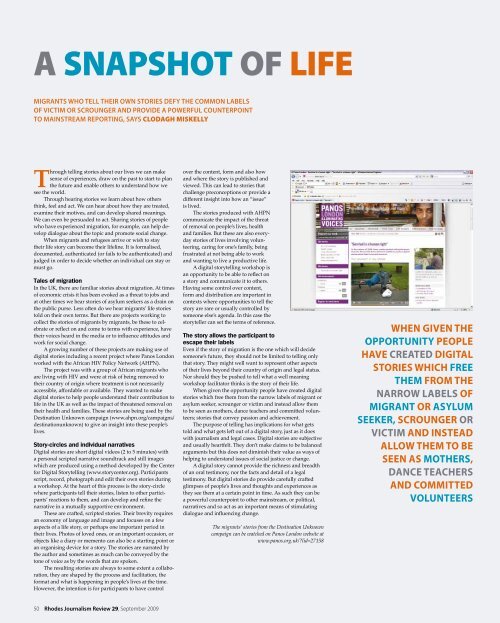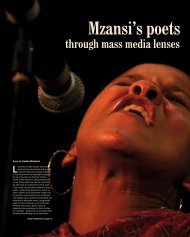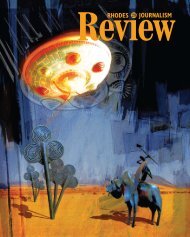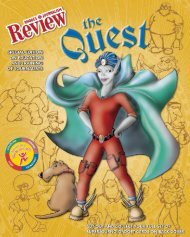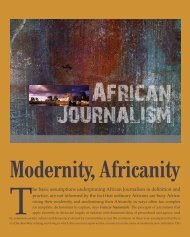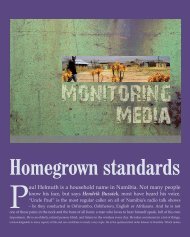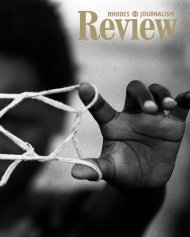Riding on the cup: - Rhodes Journalism Review - Rhodes University
Riding on the cup: - Rhodes Journalism Review - Rhodes University
Riding on the cup: - Rhodes Journalism Review - Rhodes University
You also want an ePaper? Increase the reach of your titles
YUMPU automatically turns print PDFs into web optimized ePapers that Google loves.
a snapshoT of life<br />
mIgRANTS WHO TEll THEIR OWN STORIES DEFy THE COmmON lABElS<br />
OF vICTIm OR SCROUNgER AND PROvIDE A POWERFUl COUNTERPOINT<br />
TO mAINSTREAm REPORTINg, SAyS clodaGh miskelly<br />
Through telling stories about our lives we can make<br />
sense of experiences, draw <strong>on</strong> <strong>the</strong> past to start to plan<br />
<strong>the</strong> future and enable o<strong>the</strong>rs to understand how we<br />
see <strong>the</strong> world.<br />
Through hearing stories we learn about how o<strong>the</strong>rs<br />
think, feel and act. We can hear about how <strong>the</strong>y are treated,<br />
examine <strong>the</strong>ir motives, and can develop shared meanings.<br />
We can even be persuaded to act. Sharing stories of people<br />
who have experienced migrati<strong>on</strong>, for example, can help develop<br />
dialogue about <strong>the</strong> topic and promote social change.<br />
When migrants and refugees arrive or wish to stay<br />
<strong>the</strong>ir life story can become <strong>the</strong>ir lifeline. It is formalised,<br />
documented, au<strong>the</strong>nticated (or fails to be au<strong>the</strong>nticated) and<br />
judged in order to decide whe<strong>the</strong>r an individual can stay or<br />
must go.<br />
Tales of migrati<strong>on</strong><br />
In <strong>the</strong> UK, <strong>the</strong>re are familiar stories about migrati<strong>on</strong>. At times<br />
of ec<strong>on</strong>omic crisis it has been evoked as a threat to jobs and<br />
at o<strong>the</strong>r times we hear stories of asylum seekers as a drain <strong>on</strong><br />
<strong>the</strong> public purse. Less often do we hear migrants’ life stories<br />
told <strong>on</strong> <strong>the</strong>ir own terms. But <strong>the</strong>re are projects working to<br />
collect <strong>the</strong> stories of migrants by migrants, be <strong>the</strong>se to celebrate<br />
or reflect <strong>on</strong> and come to terms with experience, have<br />
<strong>the</strong>ir voices heard in <strong>the</strong> media or to influence attitudes and<br />
work for social change.<br />
A growing number of <strong>the</strong>se projects are making use of<br />
digital stories including a recent project where Panos L<strong>on</strong>d<strong>on</strong><br />
worked with <strong>the</strong> African HIV Policy Network (AHPN).<br />
The project was with a group of African migrants who<br />
are living with HIV and were at risk of being removed to<br />
<strong>the</strong>ir country of origin where treatment is not necessarily<br />
accessible, affordable or available. They wanted to make<br />
digital stories to help people understand <strong>the</strong>ir c<strong>on</strong>tributi<strong>on</strong> to<br />
life in <strong>the</strong> UK as well as <strong>the</strong> impact of threatened removal <strong>on</strong><br />
<strong>the</strong>ir health and families. These stories are being used by <strong>the</strong><br />
Destinati<strong>on</strong> Unknown campaign (www.ahpn.org/campaigns/<br />
destinati<strong>on</strong>unknown) to give an insight into <strong>the</strong>se people’s<br />
lives.<br />
Story-circles and individual narratives<br />
Digital stories are short digital videos (2 to 5 minutes) with<br />
a pers<strong>on</strong>al scripted narrative soundtrack and still images<br />
which are produced using a method developed by <strong>the</strong> Center<br />
for Digital Storytelling (www.storycenter.org). Participants<br />
script, record, photograph and edit <strong>the</strong>ir own stories during<br />
a workshop. At <strong>the</strong> heart of this process is <strong>the</strong> story-circle<br />
where participants tell <strong>the</strong>ir stories, listen to o<strong>the</strong>r participants’<br />
reacti<strong>on</strong>s to <strong>the</strong>m, and can develop and refine <strong>the</strong><br />
narrative in a mutually supportive envir<strong>on</strong>ment.<br />
These are crafted, scripted stories. Their brevity requires<br />
an ec<strong>on</strong>omy of language and image and focuses <strong>on</strong> a few<br />
aspects of a life story, or perhaps <strong>on</strong>e important period in<br />
<strong>the</strong>ir lives. Photos of loved <strong>on</strong>es, or an important occasi<strong>on</strong>, or<br />
objects like a diary or memento can also be a starting point or<br />
an organising device for a story. The stories are narrated by<br />
<strong>the</strong> author and sometimes as much can be c<strong>on</strong>veyed by <strong>the</strong><br />
t<strong>on</strong>e of voice as by <strong>the</strong> words that are spoken.<br />
The resulting stories are always to some extent a collaborati<strong>on</strong>,<br />
<strong>the</strong>y are shaped by <strong>the</strong> process and facilitati<strong>on</strong>, <strong>the</strong><br />
format and what is happening in people’s lives at <strong>the</strong> time.<br />
However, <strong>the</strong> intenti<strong>on</strong> is for participants to have c<strong>on</strong>trol<br />
50 <strong>Rhodes</strong> <strong>Journalism</strong> <strong>Review</strong> 29, september 2009<br />
over <strong>the</strong> c<strong>on</strong>tent, form and also how<br />
and where <strong>the</strong> story is published and<br />
viewed. This can lead to stories that<br />
challenge prec<strong>on</strong>cepti<strong>on</strong>s or provide a<br />
different insight into how an “issue”<br />
is lived.<br />
The stories produced with AHPN<br />
communicate <strong>the</strong> impact of <strong>the</strong> threat<br />
of removal <strong>on</strong> people’s lives, health<br />
and families. But <strong>the</strong>se are also everyday<br />
stories of lives involving volunteering,<br />
caring for <strong>on</strong>e’s family, being<br />
frustrated at not being able to work<br />
and wanting to live a productive life.<br />
A digital storytelling workshop is<br />
an opportunity to be able to reflect <strong>on</strong><br />
a story and communicate it to o<strong>the</strong>rs.<br />
Having some c<strong>on</strong>trol over c<strong>on</strong>tent,<br />
form and distributi<strong>on</strong> are important in<br />
c<strong>on</strong>texts where opportunities to tell <strong>the</strong><br />
story are rare or usually c<strong>on</strong>trolled by<br />
some<strong>on</strong>e else’s agenda. In this case <strong>the</strong><br />
storyteller can set <strong>the</strong> terms of reference.<br />
The story allows <strong>the</strong> participant to<br />
escape <strong>the</strong>ir labels<br />
Even if <strong>the</strong> story of migrati<strong>on</strong> is <strong>the</strong> <strong>on</strong>e which will decide<br />
some<strong>on</strong>e’s future, <strong>the</strong>y should not be limited to telling <strong>on</strong>ly<br />
that story. They might well want to represent o<strong>the</strong>r aspects<br />
of <strong>the</strong>ir lives bey<strong>on</strong>d <strong>the</strong>ir country of origin and legal status.<br />
Nor should <strong>the</strong>y be pushed to tell what a well meaning<br />
workshop facilitator thinks is <strong>the</strong> story of <strong>the</strong>ir life.<br />
When given <strong>the</strong> opportunity people have created digital<br />
stories which free <strong>the</strong>m from <strong>the</strong> narrow labels of migrant or<br />
asylum seeker, scrounger or victim and instead allow <strong>the</strong>m<br />
to be seen as mo<strong>the</strong>rs, dance teachers and committed volunteers;<br />
stories that c<strong>on</strong>vey passi<strong>on</strong> and achievement.<br />
The purpose of telling has implicati<strong>on</strong>s for what gets<br />
told and what gets left out of a digital story, just as it does<br />
with journalism and legal cases. Digital stories are subjective<br />
and usually heartfelt. They d<strong>on</strong>’t make claims to be balanced<br />
arguments but this does not diminish <strong>the</strong>ir value as ways of<br />
helping to understand issues of social justice or change.<br />
A digital story cannot provide <strong>the</strong> richness and breadth<br />
of an oral testim<strong>on</strong>y, nor <strong>the</strong> facts and detail of a legal<br />
testim<strong>on</strong>y. But digital stories do provide carefully crafted<br />
glimpses of people’s lives and thoughts and experiences as<br />
<strong>the</strong>y see <strong>the</strong>m at a certain point in time. As such <strong>the</strong>y can be<br />
a powerful counterpoint to o<strong>the</strong>r mainstream, or political,<br />
narratives and so act as an important means of stimulating<br />
dialogue and influencing change.<br />
The migrants’ stories from <strong>the</strong> Destinati<strong>on</strong> Unknown<br />
campaign can be watched <strong>on</strong> Panos L<strong>on</strong>d<strong>on</strong> website at<br />
www.panos.org.uk/?lid=27158<br />
When given The<br />
oPPorTuniTy PeoPle<br />
have CreaTed digiTal<br />
sTories WhiCh free<br />
Them from The<br />
narroW laBels of<br />
migranT or asylum<br />
seeker, sCrounger or<br />
viCTim and insTead<br />
alloW Them To Be<br />
seen as moThers,<br />
danCe TeaChers<br />
and CommiTTed<br />
volunTeers


